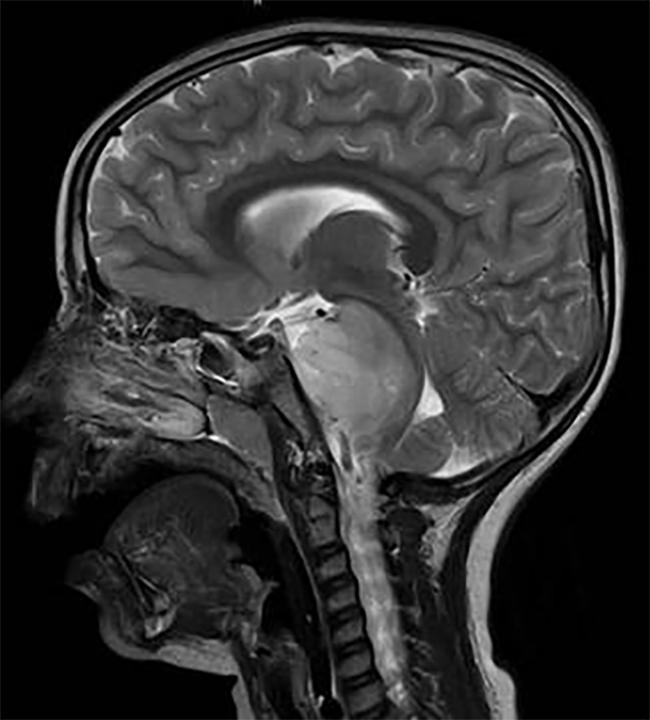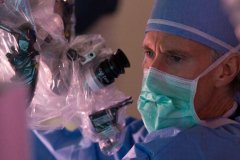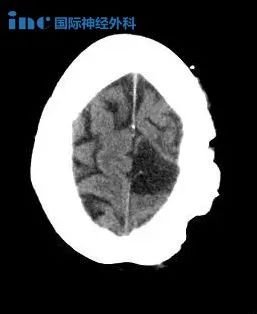Abstract
Abstract Background Various synthetic materials are used in neurosurgery and left in place intentionally during surgery for several purposes such as hemostasis,dural closure,or cranioplasty.Although leaving such substances in surgical sites is considered safe,in general,foreign body granuloma may occur months or years after intracranial surgery.Thus,far relatively little is known about treatment and outcome of such lesions.Methods A systematic review of 3466 histopathological examinations after cranial surgeries achieved over a 13-year period was performed.After excluding patients with Teflon granulomas or infection,a total of 12 patients with foreign body granulomas induced by synthetic material used in a prior surgery were identified.Patient records,imaging studies,and histopathological data were analyzed.Furthermore,postoperative outcome was assessed.Results Mean age at the second surgery was 51 years(range,11–68 years).The median time between the primary and the secondary surgery was 13 months(range,1–545 months).Eight patients(75%)presented with signs and symptoms related to the foreign body granulomas.Total resection of the foreign body granulomas was performed in all patients.The granulomas were induced by oxidized cellulose polymer(n=6),suture material(n=3),Gelfoam(n=1),methylmethacrylate(n=1),and bone wax(n=1).The mean postoperative follow-up time was 54 months(range 1–137 months).There was symptomatic improvement in all instances.Imaging studies did not demonstrate any recurrence.Conclusion Despite its rarity,foreign body granuloma should be taken into consideration in the differential diagnosis of intracranial mass lesions especially in cases of suspected tumor recurrence after prior surgery.The pathogenesis of foreign body granuloma still needs further clarification.Our study demonstrates that they have good prognosis after surgical removal.
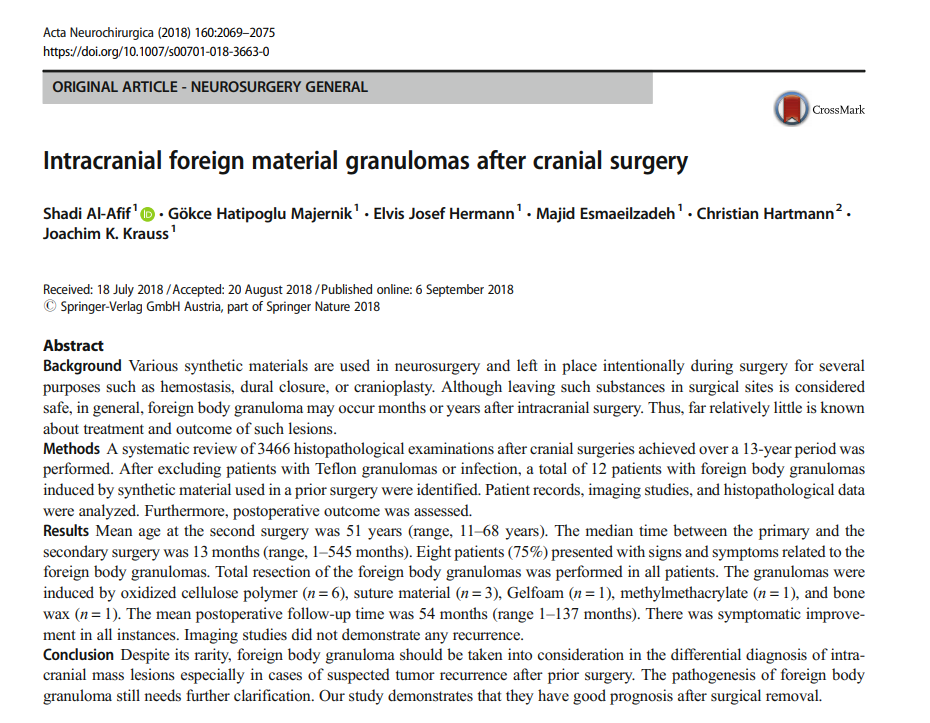
背景:神经外科手术中会使用各种合成材料,有些在手术过程中将故意留在原位,用于止血、闭合硬脑膜或颅骨成形术。尽管将这些物质留在手术部位被认为是顺利的,但一般来说,异物肉芽肿可能在颅内手术后数月或数年内发生。因此,对此类病变的治疗和预后知之甚少。
方法:我们对13年来接受颅外科手术的3466例组织病理学检查进行了系统回顾。排除非感染性肉芽肿或感染的患者后,共有12名患者在先前的手术中使用合成材料诱发异物肉芽肿。分析患者记录、影像学研究和组织病理学数据。此外,还将评估术后疗效。
结果:
二次手术的平均年龄为51岁(11-68岁)。一开始手术和二次手术之间的平均时间为13个月(范围为1-545个月)。8例(75%)患者出现与异物肉芽肿相关的体征和症状。全部患者均行异物肉芽肿全切除术。肉芽肿由氧化纤维素聚合物、缝合材料、明胶海绵、甲基丙烯酸甲酯和骨蜡诱发。术后平均随访54个月(1~137个月)。全部病例的症状均有好转。影像学检查没有发现任何复发。
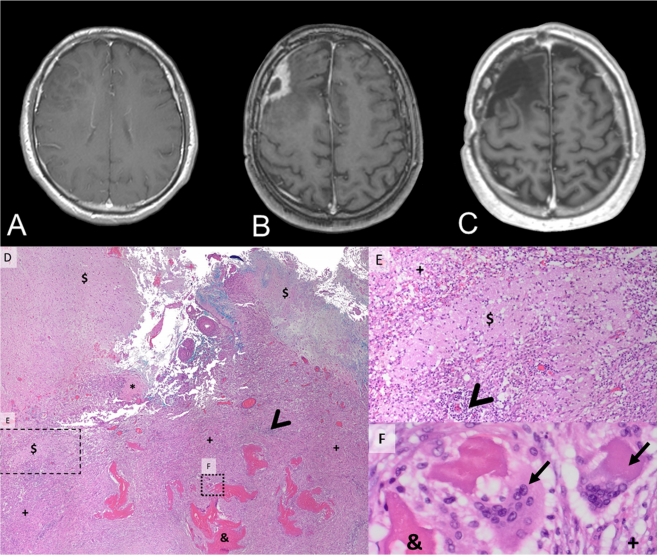
介绍:宿主对异物的过敏反应是一种常见现象,是许多疾病的病理基础。一般发生在胃肠道或直接呼吸道环境下。然而,内脏或颅内腔的异物反应是少见的,需要事前沿行创伤或手术。神经外科手术中使用各种合成材料,并有意将其留在原位,以达到止血、闭合硬脑膜、微血管减压、包裹脑动脉瘤或修复颅骨骨缺损等目的。这些药物主要是异物,可能会引起异物反应,导致慢性肉芽肿性炎症。先前手术后有肿块效应的异物肉芽肿在普通外科中多用棉絮状肉芽肿、肉芽肿和肉芽肿等术语来描述。在普通外科手术中,这些异物反应通常构成医源性错误,而在神经外科中,异物反应是由故意留在原位的材料引起的。具有肿块效应的异物肉芽肿可能在术后数月或数年后出现,在影像学研究中可能会模拟肿瘤或脑脓肿,给治疗医师带来诊断上的挑战,是当误诊可能使患者接受不必要的治疗(如放射线和/或化疗)时。此外,异物肉芽肿可能导致新的体征或症状,如癫痫、颅神经麻痹、水肿、偏瘫或脑积水。术后颅内异物肉芽肿在过去40年的病例报告和小系列中均有记载,但除了特氟龙肉芽肿外,神经外科医生似乎低估了这一临床问题的重要性。在这里,我们报告了一系列的12个病人,在我们的治疗中心,在过去的13年中,在颅外科手术后出现肿胀性异物肉芽肿。在全部的病人中,二次手术切除肿瘤样病变并确定诊断。
结论:异物肉芽肿虽然少见,但在颅内肿块病变的鉴别诊断中,是在术后怀疑肿瘤复发的病例中,应考虑到异物肉芽肿。异物肉芽肿的发病机制尚需进一步阐明。我们的研究显示,他们在手术切除后预后良好。
关于德国Joachim K.Krauss教授

INC国际神经外科顾问团(WANG)成员之一的德国Joachim K.Krauss教授是国际功能性神经外科专家,主要的临床研究集中在复杂的脊柱神经外科手术、功能性神经外科手术(帕金森病、癫痫)和颅底手术上,提出了脊柱治疗上的几个新的治疗概念。
Joachim K.Krauss教授的擅长包括神经肿瘤学、小儿神经外科、血管神经外科、颅底神经外科、脊柱外科、脊柱外科、重建立体定向与功能神经外科、创伤神经外科、疼痛神经外科、脑积水外科等,涵盖面较为广泛,是神经外科领域的全能型专家。与此同时,Joachim K.Krauss教授在德国汉诺威医学院(MHH)中的医疗团队由高度化的专家组成,并在神经外科治疗中合适使用计算机断层扫描(CT)和磁共振成像(MRI),从而合适将患者的治疗提高到平均值以上。
原文链接:https://www.sci-hub.pl/10.1007/s00701-018-3663-0
- 文章标题:INC德国Joachim K.Krauss教授:颅脑手术后颅内异物肉芽肿
- 更新时间:2020-07-31 14:08:50

 400-029-0925
400-029-0925
